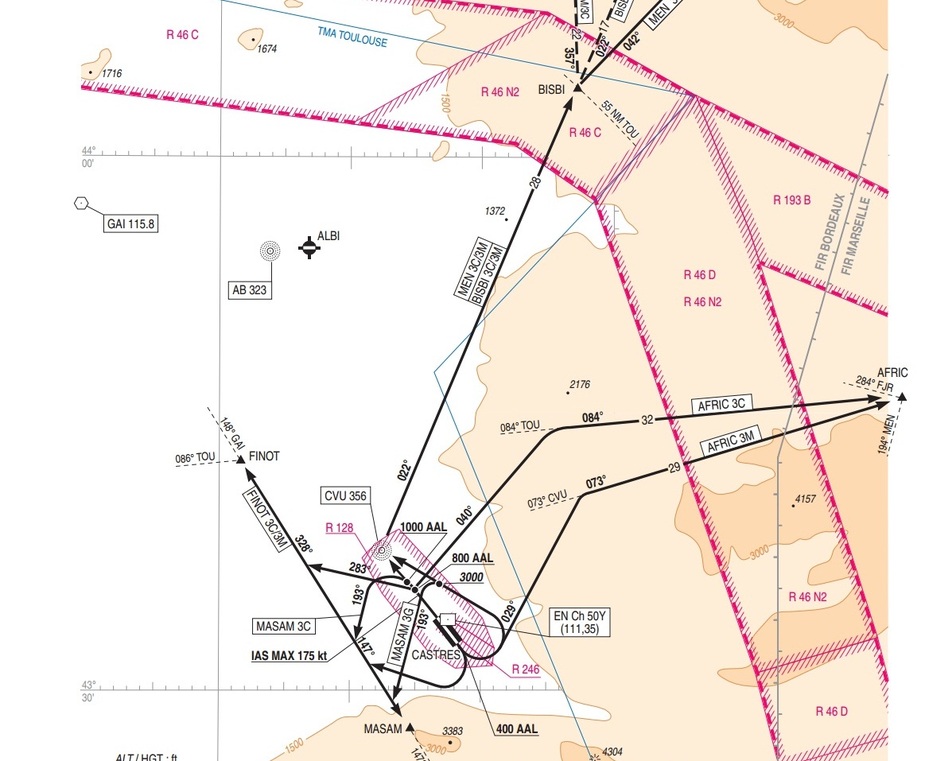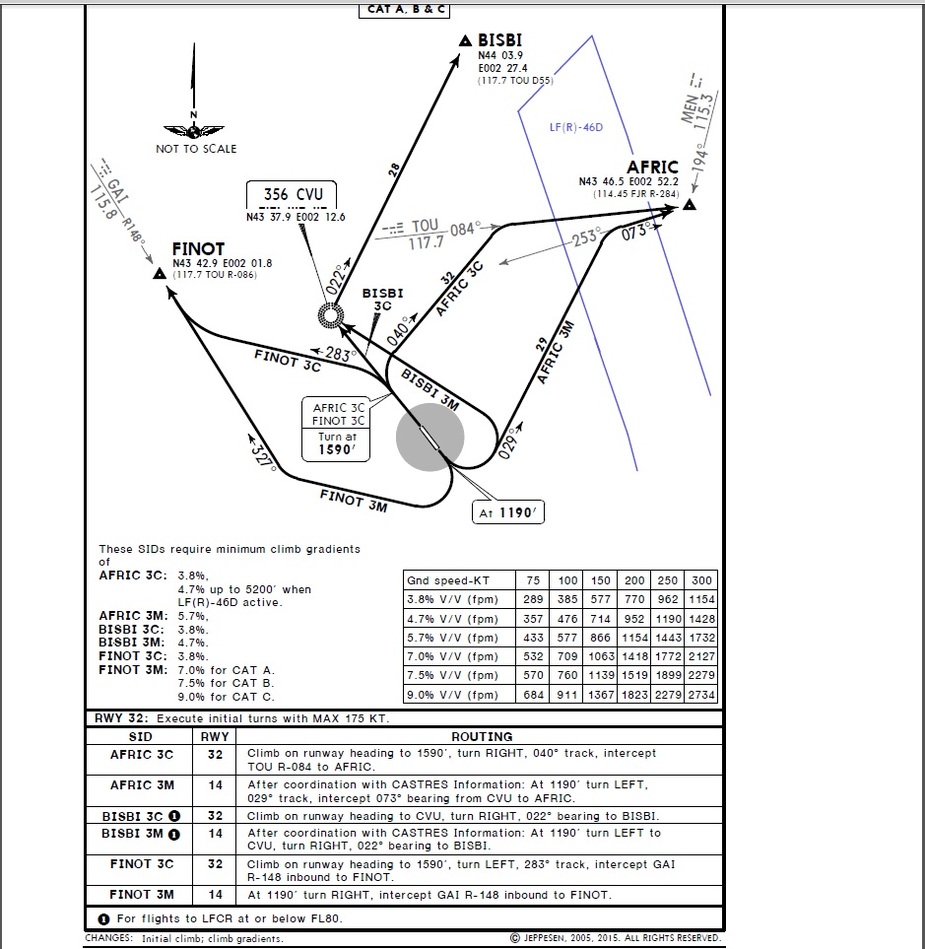Peter wrote:
What exactly do you get for your money? Do you get some sort of RNAV procedure, made up of waypoints which are loaded into the GPS as user waypoints, or have they done a deal with Jepp to merge their “custom SID” into the Jepp database?
Nobody but Jeppesen is allowed to tinker with a Jeppesen database  and that includes pilots and companies like APG. At least in the world of commercial aviation. Nobody but an approved database provider (like Jeppesen or Honeywell and companies contracted and approved by them) may alter or insert any waypoints into a navigation database.
and that includes pilots and companies like APG. At least in the world of commercial aviation. Nobody but an approved database provider (like Jeppesen or Honeywell and companies contracted and approved by them) may alter or insert any waypoints into a navigation database.
Most (if not all) APG escape procedures are non-RNAV procedures similar to missed approach procedures of instrument approaches. As an example I will provide the procedure for my homebase for my flight tomorrow morning (hoping not to get sued for copyright violation). Note that this is aircraft specific and also specific for tomorrow’s aircraft TOM:
************************************************************************** ************************************************************************** * * *********** SPECIAL DEPARTURE PROCEDURES *********** * * ************************************************************************** * * * * * STUTTGART, DEU EDDS * * STUTTGART 08 Dec 15 * * * * * * Rwy TAKEOFF WEIGHTS FOR RWY 25DP REQUIRE * * 25DP USE OF THIS TAILORED NON-RNAV DEPARTURE * * PROCEDURE: * * * * NOTE: NON-RNAV PROCEDURE. ALL FIXES * * ARE FLY-OVER FIXES UNLESS OTHERWISE * * NOTED. * * * * CLIMB STRAIGHT AHEAD ALONG STG VOR R-252. * * * * AT STG VOR D2.5, MAKE A 15 DEGREE BANKED * * CLIMBING -LEFT- TURN DIRECT STG VOR. * * * * INTERCEPT STG VOR R-012 OUTBOUND DIRECT * * LBU VOR. * * * * CLIMB IN HOLDING PATTERN AT LBU VOR. * * (NORTH, LEFT TURNS, 177 INBOUND). * * * * ### * * * * * ************************************************************************** ************************************************************************** * These procedures describe the non-standard, one engine * * inoperative, departure flight path. The maximum allow- * * able takeoff weights, presented in the attached analysis, * * are based upon the procedure(s) outlined above. * * * **************************************************************************apg
Peter wrote:
Since the mountains don’t move, what stops somebody paying for the design just once?
Theoretically, you could do that. Subscribe to APG for one month and pay a student to calculate procedures for every runway using the most unfavorable combination of TOM, wind and temperature. But this may result in inefficient procedures.
The good thing about services like APG is that they calculate the best procedure for every single flight under present conditions. For commercial operators, the runway analysis (max. allowed takeoff- and landing mass for present conditions: wind, temperature, slope, contamination) is much more useful than the escape procedures (which are only required for a handful of aerodromes anyway).
what_next wrote:
I can’t imagine that there exists any civilian twin engined aircraft that is able to do 14% on one engine at 8000ft.
But it is not the climb gradient at 8000 ft that should be 14%, but the average climb gradient from the airport to 8000 ft. (Not that I think it would help much.)
APG puts this well in their FAQ:
For the purposes of analyzing performance on procedures developed under TERPS or PANS-OPS, it is understood that any gradient requirement, specified or unspecified, will be treated as a plane which must not be penetrated from above until reaching the stated height, rather than as a gradient which must be exceeded at all points in the path.
By the way Jason, is there a legal procedure for a twin jet to take off on ONE engine? Like for repositioning to a shop I mean. (Was it done?).
A reliable source told me this (funny) story: Russian crew of a Gulfstream V needed to position the aircraft from one Moscow airport to the other. They had some sort of problem on one engine while taxying out. ‘Ah, never mind, we are very light, we can do this on one engine’.
No issue at all taking off, but when they landed they got a less than friendly reception. Apparently, a data link (to either the Gulfstream co or the operator, I forgot) exposed them nicely.. I believe the story, not only because of the source, but also because I once spoke to another GV pilot who told me that if you are light, put the brakes on and give full power, you actually start moving forward not only burning gas but also burning rubber..
Maybe some of the jet jockeys here can elaborate on this a bit more.
Sorry for the thread drift, but you started it @Flyer59 
I believe it’s true when it was Russians … (we could open another thread about aviation in Russia)
aart – I have heard that story too from a colleague who used to be lead Captain on a Global in Moscow.
The punchline was that Gulfstream called the owner and voided his warranty and service plans.
I’m not sure quite how much I believe it but it’s a good one to tell in the bar nonetheless!
Well, this just proves that MH370 was not the only case where the crew didn’t know which CB turns off the engine monitoring satcomms 
Hello there,
Here is a question for IFR pilots, both commercial and private, related with a very basic part of an IFR flight: the Standard Instrument Departure.
We could take the example of a french SID (AFRIC 3C, LFCK), to compare IAP chart and Jeppesen one (see below).
For what I’ve been taught, one should study the SID proposal before accepting it, especially dealing with needed climb gradient [expressed in %, and, on Jeppesen charts, converted in climb rate f(speed)].
If the climb gradient is compatible with the aircraft performances, one should go without worrying, if he is able to maintain a climb rate ALWAYS at or above the needed climb rate.
The point is, during the climb, we are not always paying attention to the climb rate, and thus, lacking of “integrity check” of the climb profile.
My question is to know how experienced pilot, do confirm they are high enough at one moment during the SID ?
Having a margin between the average climb rate and the needed climb rate offers obvious security.
Relative terrain depiction allow you to monitor, and of course terrain avoidance like GPWS and SVT will be even better (aural warning).
Some SID have altitude prescription, so you know what altitude you should be at least, when reaching a waypoint.
Dealing with maps, we have two different philosophy.
Jeppesen (actual), are very clean, but say nothing about the terrain. While IAP ones do inform about the environnement.
For what I have understood, Jeppesen is improving their STAR/SID charts, integrating terrain depiction, and georeferencing, which sounds to be a great security feature. I really wonder what you think about this in your daily activity ?
All advice will be welcome !


PetitCessnaVoyageur wrote:
The point is, during the climb, we are not always paying attention to the climb rate, and thus, lacking of “integrity check” of the climb profile.
My question is to know how experienced pilot, do confirm they are high enough at one moment during the SID ?
Where it is important (especially when the required climb gradient is due to terrain) I do indeed monitor my climb rate. All the way up until reaching a safe altitude. Engage the autopilot early and monitor the important stuff! Many such departure routes have minimum crossing altitudes for specific waypoints. Check each one of them. There is no other way to do it…
what_next wrote:
Engage the autopilot early and monitor the important stuff!
So I understand you take off with the target minimum climb rate written in gold numbers into your mind, for one part.
And for the other part, that the autopilot gives you the free psychic ressources to actively monitor.
Exactly!